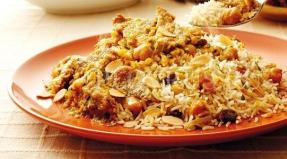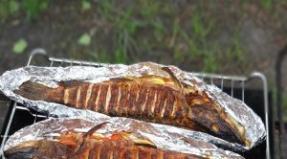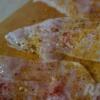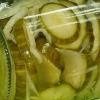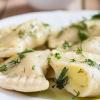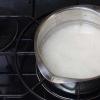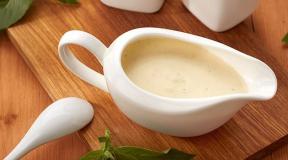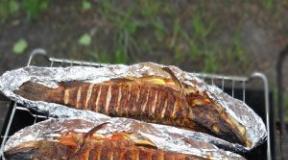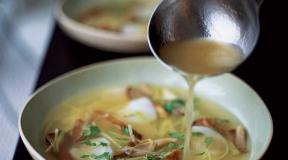Mullet - recipes for delicious Black Sea Mullet. Mullet fried in a frying pan Mullet fish is fried or better baked
Mullet is a very tasty fatty fish. It is good to salt, smoke and, of course, fry. There are several ways to prepare this Black Sea fish. Fry it in flour, breadcrumbs and batter.
How to fry mullet in cornmeal
You will need: - 500 g mullet; - 100 g corn or wheat flour; - vegetable oil for frying; - salt and ground black pepper to taste.
Clean the mullet from scales, rinse under cold water to wash off any stuck-on scales. Then cut the belly and take out the insides, also remove the dark film. Cut off the head. Wash the fish again and remove excess moisture with napkins. Cut the mullet into pieces approximately 3 cm wide. Rub the fish with salt and ground black pepper. Determine the quantity according to your preference. Pour corn flour into a plate; if you don’t have it, replace it with wheat flour. Place the frying pan on the stove, pour in vegetable oil and turn on medium heat. When the oil is hot, take the mullet pieces and coat them in cornmeal, then place them in the pan. Fry until golden brown, then turn over and fry again. Serve the finished mullet with fried potatoes and vegetable salad.
How to fry mullet breaded with breadcrumbs
You will need: - 500 g mullet; - 3 eggs; - 5 tbsp. breadcrumbs; - vegetable oil for frying; - ground black pepper and salt to taste.
Clean the mullet from scales and entrails, wash and cut into portions. Remove large bones and backbone. Pour the beaten eggs into a bowl, add salt and pepper, and stir. Place the fish in the bowl with the egg mixture. Heat vegetable oil in a frying pan. Place breadcrumbs on a plate. Remove the mullet pieces from the egg mixture and roll in breadcrumbs, then fry on both sides. Serve with rice or potatoes.
After working with fish, a specific smell remains on tools and hands for a long time. To get rid of it quickly, wash with cold water and soap.
Irina Kamshilina
Cooking for someone is much more pleasant than for yourself))
Content
Fried, stewed, baked, salted or smoked mullet will bring you a lot of pleasure and benefit to your body. Many recipes for preparing this simple fish variety will allow you to make both the first and second courses, or create an appetizer for beer. Juicy white meat with a moderate fishy aroma does not require special manipulations during cooking or complex soaking. A few spices, vegetables, salt - all you need to give amazing taste and aroma to fish of the mullet family.
What is a mullet
The warm waters are home to the commercial fish mullet. Habitat: sea. The population of the mullet family lives in the seas of subtropical and tropical regions. Some of the species can live in freshwater rivers. They can grow up to a length of 50 cm. Individuals are characterized by shiny scales and a small mouth. Gray mullet are distinguished by great mobility; they can jump out of the water and jump over fences.
These representatives of the ichthyofauna have a body shaped like a torpedo. The scales are large and round. The nose of the fish is located at the same level as the dorsal fin. The lifespan of sea and river inhabitants is up to 15 years. Sexual maturity of males occurs at 6-7 years, and spawning of females is possible at 8-9 years. There are more than 100 subspecies of this fish, living in different bodies of water:
- mullet mullet (black) - a popular large variety, whose habitat is the Japanese, Azov, and Black Seas, can weigh up to 2.5 kg;
- sharpnose (chularka) - the smallest representative of the mullet, weight about 500 g, length - 25 cm,
- singil (serendaka) – a common Black Sea mullet, carcass weight – up to 1 kg;
- pelengas - habitat of the Far Eastern waters;
- hoturo, cestrets are rare species that prefer fresh water bodies.
Representatives of the family are found not only in natural conditions, in the seas, oceans, and river mouths. The high nutritional value and excellent taste of the product have led to the fact that many countries are trying to grow fish in artificial reservoirs. A decrease in the number of fish in the sea, the lack of a constant successful bite and high demand for this species among consumers are the reasons for breeding them in special complexes.

The nutritional value
The high nutritional value makes the fish a popular catch. Mullet is rich in vitamins, macro- and microelements, and beneficial acids. One of the valuable components in the composition of such a product is omega-3 fatty acids. The element is necessary for the body to maintain healthy arteries and resist the formation of blood clots, which significantly reduces the risk of heart attacks, strokes and other diseases of the cardiovascular system. The product contains protein, calcium phosphorus, necessary for the muscles and bones of the human body.
Regular consumption of this type of fish will have a beneficial effect on the condition of the skin due to the large amount of vitamin A, which promotes the production of collagen. This element is also necessary for the normal functioning of the visual organs. Another useful element from the composition is vitamin B4. With its help, you can improve the condition of the nervous system, normalize sleep, and eliminate depression. B vitamins promote good liver function and reduce blood cholesterol levels. Other useful elements of the chemical composition can be named:
- a nicotinic acid;
- phosphorus;
- fluorine;
- molybdenum;
- nickel;
- zinc;
- chromium.
Supporters of a healthy lifestyle and those who want to lose excess weight will be pleased to know that the product is low in calories. 100 grams of fresh fish meat contains only 80 to 120 kcal. Due to the lack of carbohydrates, fish is easily digested. This fact is very important when eating a low-calorie diet. Nutritionists recommend combining this product with red and green vegetables, sometimes with cereals.
How to choose
To prepare a tasty and healthy mullet dish, it is important to know the secrets of choosing fresh and high-quality fish. Experts recommend paying attention to the following signs before purchasing:
- The main characteristic of the fresh product is bulging, clear eyes with a black pupil. Cloudy eyes indicate spoilage of the fish.
- The scales on this aquatic inhabitant should remain shiny and shimmer in the sun until sold. The scales fit tightly to the carcass. If there is damage or stains on the surface, then it is better not to buy such a product.
- You can check the fish for freshness by pressing with your finger. Press your finger firmly against the carcass. The resulting hole should quickly recover. If this does not happen, look for another fish for your dinner.
- Give preference to freshly caught fish. Within 48 hours (subject to proper storage) all the beneficial properties of the product are retained. If you can’t buy a fresh carcass, pay attention to deep-frozen products. Examine the fish. It should not be damaged, and the exact date should be indicated on the box.
How to cook mullet
High nutritional value and excellent taste contribute to the emergence of many mullet dishes. This type of fish can be cooked in different ways, but more often there are recipes for mullet that call for baking or frying the raw material. Smoked, salted and dried mullet is popular; various fish soups are also prepared from it. To reveal new facets of taste, the raw materials are pre-marinated, herbs and spices are used, and served with sauces. Fish is ideal with potatoes or other vegetables.
The method of preparation largely depends on the type of fish purchased. Large pelengas are often stuffed and baked. Please note that the head of a representative of this mullet family contains poison, so it must be cut off before heat treatment begins. Caspian varieties have higher fat content than Black Sea or Azov varieties. If you are watching your caloric intake, keep this point in mind.

Cooking recipes
Due to its moderate aroma and firm structure of white meat, excellent taste characteristics and benefits for the body, this fish is in demand in the kitchens of many countries around the world. The carcass has few bones, the scales are easily separated from the body. True fish connoisseurs should go to the Black Sea coast, where they can take a freshly caught carcass and cook it themselves. If you live far from where the Black Sea mullet lives, use the frozen product to create your own little culinary masterpiece.
Recipe for buglama from mullet
- Time: 1 hour 45 minutes.
- Number of servings: 4 persons.
- Calorie content of the dish: 49 kcal/100 g.
- Purpose: lunch, dinner.
- Cuisine: Caucasian.
- Difficulty: easy.
Hearty and tasty buglama made from mullet fish is one of the dishes of national Caucasian cuisine. The abundance of herbs, spices, colorful vegetables combined with white fish meat will surprise and delight you and your loved ones. The quantity and composition of vegetable components can be varied to suit your taste. If you are preparing this Caucasian dish for the first time, follow the proportions indicated in the recipe. The treat is easy to prepare and the process will not take much of your time.
Ingredients:
- mullet – 300 g;
- garlic – 3 teeth;
- tomatoes – 4 pcs.;
- chili pepper – 1 pc.;
- onions – 2 pcs.;
- salad pepper – 2 pcs.;
- cilantro, dill - 1 bunch each;
- potatoes – 4-5 pcs.;
- water – 0.5 l;
- paprika, suneli hops, salt, pepper - to taste.
Cooking method:
- Prepare your food. Wash the fish carcass, remove scales, remove fins and entrails.
- Cut the fish into small cubes (3-4 cm), removing the bones.
- Wash the bell peppers, remove seeds and cut into cubes.
- Remove the skin from the tomatoes. To do this, make a cross cut on the surface of the vegetable, lower it into boiling water, and then into cold water. After this procedure, the skin is easily separated from the pulp. Cut the tomatoes into cubes.
- Peel the onion and cut into half rings.
- Place the prepared foods in layers in a thick-walled saucepan or deep frying pan in the following order: fish, potatoes, onions, peppers, tomatoes.
- The top layer is chopped greens.
- Add spices and salt, fill the dish with water.
- Cover the pot or pan with a lid and place on the stove. Cook over low heat for about 45 minutes until done.
- When serving, garnish with herbs. You can serve the dish with warm pita bread.

With lemongrass and fennel
- Time: 1 hour 10 minutes.
- Number of servings: 6 persons.
- Calorie content of the dish: 121 kcal/100 g.
- Purpose: lunch, dinner.
- Cuisine: international.
- Difficulty: easy.
Fish of the mullet family do not belong to expensive or rare varieties. From an inexpensive carcass you can make a small work of culinary art if you choose the right spices and herbs. Experts say that fennel and lemongrass are best suited for this type of fish. In combination with each other, they give the white tender meat a subtle aniseed sourness. The appetizer is worthy not only of an everyday, but also a festive table. The treat will be especially beneficial if the catch was fresh, but frozen fish will not spoil the taste of the finished dish.
Ingredients:
- mullet – 3 kg;
- fennel – 1 pc.;
- lemon grass – 4 tbsp. l.;
- lemon – 1 pc.;
- cilantro (parsley) – 100 g;
- ginger – 30 g;
- garlic – 4 teeth;
- olive oil – 50 ml;
- salt, black pepper - to taste.
Cooking method:
- Wash the carcasses, remove scales, and remove the entrails.
- Wash the lemon, cut into slices along with the peel.
- Chop the ginger and garlic.
- Stuff the carcasses with a mixture of herbs with roots, lemon slices, chopped garlic and ginger. Season with salt, pepper and olive oil.
- Preheat the oven to 140 degrees. Bake the fish at this temperature for an hour.
- When serving, garnish with fennel sprigs. Can be served with white or rose wine.

Secrets of cooking delicious mullet
Tender, nutritious, juicy and tasty fish is suitable for everyday and festive tables. It is boiled, stewed, baked, smoked, and canned. Treats made from this aquatic creature can be found in the national cuisines of many nations around the world, including Russia. To ensure perfect mullet dishes, use the following recommendations from experts:
- Before working with fish, immerse it in very hot water for half an hour. This technique will simplify the process of removing scales. Start from the tail.
- When baking a dish in the oven, be sure to preheat it. The optimal temperature for this type of heat treatment is 180 degrees. It will take about 20 minutes to finish cooking unless the recipe says otherwise. If the carcasses are kept in the oven for a long time, the meat will become dry.
Calories: Not specified
Cooking time: Not indicated
Mullet fried in a frying pan is perfect for any table. In principle, you can fry any fish, both sea and river, both fillet and whole fish. We chose mullet - this fish is very tasty, moderately fatty, the mullet meat is tender and juicy. It is easy to clean, quick and easy to cook. For frying, it is better to take a small fish weighing 300-400 grams. By the way, if you can’t eat fried food, take a look.
This recipe will describe in detail how to clean fresh fish. You can, of course, ask to clean the fish where you buy it, but it costs money, and you will still have to learn sooner or later. In addition, you are unlikely to clean the fish perfectly, and, most likely, at home you will need to remove the entrails from the fish and remove the remaining scales.
What we need:
- fresh mullet – 2 pcs. (700-800 gr);
- salt and freshly ground black pepper - to taste;
- refined vegetable oil – 4-5 tbsp. l;
- flour – 4 tbsp. l.
How to cook with photos step by step
Wash the fish with cold water. If the fish is covered with mucus (this is often found in river fish), then sprinkle it with coarse salt, wipe it and wash it again. Now your hands will not slip and the fish will be easier to handle. We hold the knife perpendicular to the fish. With the sharp side of the knife, we begin to scrape the fish against the scales, moving from the tail to the head. You need to clean from all sides, especially carefully under the fins. Then we cut off the head immediately behind the gills, retreating 1-2 cm from the gill slit. We rip open the abdomen and free the fish from the entrails. Remove the black film from the abdominal cavity and thoroughly wash the gutted fish. 
Trim the fins and tail with kitchen scissors. We cut the mullet into not very large pieces, 4-5 cm wide (larger pieces will not have time to fry evenly). We do not remove the skin.

If the pieces of fish are too wet, blot them with a paper towel, otherwise the salt will melt and the fish will taste bland. Season the fish with salt and ground black pepper. Stir, rubbing salt and pepper into the fish pieces. Let it soak.

Before frying, the fish must be breaded. For breading, use wheat or corn flour, sesame seeds, fry fish breaded with a mixture of egg and flour, alternately dip it in flour and egg. We will have the simplest breading option - in wheat flour. Pour flour into a plate and roll the pieces of fish on all sides.

Heat the vegetable oil in a frying pan; there should be enough of it so that the mullet is fried in the pan and does not burn. The fish will not absorb excess oil, and if there is not enough of it, the flour will begin to burn, the fish will not be fried and will end up with an unpleasant aftertaste. When the oil is hot enough, place the fish pieces at a short distance and turn the heat to medium. Fry the fish for 5-6 minutes on one side, without turning over, until golden brown.

Then use a spatula to pry it up and turn the fish over to the other side. Fry the pieces on the other side. In general, frying takes 10-12 minutes depending on the size of the piece. 
That's all, the fried mullet is ready. According to these rules, any fish is fried, adjusting the frying time. It depends not only on the size of the fish pieces, but also on the fish you are cooking. Small sea fish with dryish meat (hake, pollock) fry faster, large river fish (for example, silver carp) will fry a few minutes longer. 
You can serve fried mullet hot or cooled, with any side dish, vegetable salad, or as an independent dish, supplemented with herbs and a slice of lemon.
First, buy the freshest mullet on the market. There you can decide on the desired size and number of fish per serving. As practice has shown, on the Black Sea market, at least, you can find mullet, packaged according to size into 4 groups. For an adult, 2-3 small fish will be enough. This is if the fried mullet comes with a side dish and good white wine.

Clean and gut the fish yourself under running water, unless you ask to do this at the market. Cleaning a mullet is easy. Just be careful when you remove your fish's gallbladder. Cut off all fins, including the tail one, and cut off the head. This will make it easier to place the mullet in the pan and easier to turn over when frying. Rub each carcass inside and out with salt and ground white (or black) pepper. You can roll the fish in flour, but this is not necessary.

Heat a little vegetable oil in a frying pan, lower the heat slightly and place the mullet in a row. Fry on each side for several minutes. I’m not specifically writing the exact time; decide for yourself to what extent you want to gild the crispy skin of the mullet. The main thing is that the fish has time to fry, remains juicy, and does not dry out. I don’t recommend covering the frying pan with a lid, although this will definitely bring the fish to readiness faster, but you may be left without a crispy crust. All! Fried mullet is ready. Place the fish on plates, garnish with boiled potatoes fried in butter, and sprinkle with chopped dill. Wash it down with the terroir wine “Alma White” from the Alma Valley (Bakhchisaray district). Bon appetit!
Already read: 6500 timesA holiday at sea means fruits, vegetables, homemade wine and, of course, fish. I recommend that when traveling around Crimea, you must buy fresh sea fish. Why? Yes, if only because freshly caught sea fish is much healthier and tastier than frozen or chilled. So, how to choose fresh mullet, pelengas and red mullet? Read on to learn how to prepare delicious dishes from these types of fish, as well as tips on processing and storage.
How to choose and cook mullet?
Fishing places / How to choose and buy fresh sea fish?
I already wrote about mullet in the article Mullet fish / What to cook from mullet? , but it wouldn’t hurt to tell you a little more about the delicious southern fish.
The name “mullet” comes from the Greek word cephalus, which means “head”. Therefore, people living on the Black Sea coast gave this fish other names, for example, “chub” or “scallop”.
Mullet is a very tasty and low-fat fish. It has practically no small bones and little fat, so it is considered a dietary product. Only 88 kcal per 100 g.
The fat in mullet contains omega-3 polyunsaturated acids, which help prevent atherosclerosis. They are also included in pharmaceutical fish oil in solution and capsules.
The beneficial fatty acids in fish help our skin maintain the surface lipid film of the skin, protecting it from the penetration of pathogenic bacteria.
Mullet also contains a large amount of protein (almost 20%), phosphorus, zinc (so necessary for the formation of germ cells), as well as manganese, potassium and iodine.
Scientific research proves that the mullet is one of the richest fish in phosphorus on the planet. It takes a worthy second place after tuna. By the way, sprat is in third place in terms of phosphorus. Yes, yes, the same sprat.
How to choose fresh mullet?
The most important thing in choosing a mullet is the location. Don't expect fish bought from a vendor on the side of the road to be fresh and safe.
Try to find a specialty store or market where the fish is kept in a special container or box with ice.
It's best if there is a lot of it. This is also important. This way you have more choice and the opportunity to choose exactly what you need. Ideally, mullet should be purchased from the fishermen themselves.
I was able to buy a mullet several times straight from the networks. Fishermen will be happy to choose the largest and most beautiful fish and sell it at a reasonable price.
- When choosing a mullet, look to see if the eyes are transparent. If they are cloudy, then the fish is not fresh.
- The fish's gills should be pink and clean.
- The meat of a fresh carcass should be elastic, the carcass should smell like the sea.
When buying fish at the market or in a store, you should definitely be offered to clean it. Don't refuse. The mullet is a boneless fish, but its scales are like those of a carp, only the carp is rounder, and the mullet is elongated in shape.
Because of the shape of the mullet’s body, cleaning it is quite labor-intensive, especially if it is the first time in your kitchen.
If you bought a mullet while on vacation, then ask to remove the head, but do not cut the carcass into pieces. You can handle this just fine yourself.
And one more tip: mullet is not a large fish, so you should not cut the carcass into too small pieces. Mullet cooked in large pieces or whole is especially delicious!
How to store fresh mullet?
A carcass without head and gills, thoroughly washed and dried, can be stored in the refrigerator for no more than 2 days. For longer storage, the mullet should be wrapped in foil, placed in a vacuum container and put in the freezer. It will keep in this form for 2 months.
How to cook mullet? / Crimean recipes
You can prepare mullet in different ways. You can cook fish soup, bake, fry, etc.
By the way, if you want to fry a mullet, I recommend doing it without oil and in a frying pan with a ceramic coating.
Crimean mullet soup
Ingredients:
- one mullet fillet
- parsley and celery
- parsley root
- pepper to taste
Cooking method:
- Cover the mullet fillet with water and boil until tender.
- Then remove the fillet, cut into portions and set aside.
- Grate the parsley root, add to the strained broth and bring to a boil.
- Then add greens and pieces of fish. Add salt and pepper to taste. Bring to a boil again. The soup is ready.
In coastal restaurants in Black Sea resorts, a wonderful dish is often prepared from mullet - pillaki. This is a tasty and quick dish of Greek cuisine, adapted to the Black Sea Crimean cuisine.
Mullet pilaki
Ingredients:
- 3 mullet steaks
- 2 carrots
- 6 pcs. potatoes
- 2 lemons
- 4 things. onions
- Greenery
- ground pepper
- vegetable oil for frying
Cooking method:
- Wash the mullet steaks, dry them and place on a greased baking sheet. Squeeze the juice from one lemon, cut the second into slices.
- Sprinkle the fish with lemon juice, salt and pepper to taste, cover with parchment paper and leave on the table to marinate.
- Fry the onion in half rings in vegetable oil, then the carrots in long slices. Fry the potato slices in the same oil. Place vegetables in layers around the fish, add salt and pepper.
- Cut the carrots into slices. Cut the potatoes into slices.
- Bake for about 20 minutes in a hot oven. Important! Mullet dries out quickly in the oven, so do not remove the paper during cooking!
- Transfer the finished fish to a plate, garnish with herbs and lemon slices.
Mullet aspic
Ingredients:
- 1 kg mullet
- 1 p. gelatin
- onion
- carrot
- peppercorns
- Bay leaf
Cooking method:
- Gut the mullet, remove the gills and place in a saucepan. Pour water over the fish until it just barely covers it. Add salt, pepper and bay leaf. Place over medium heat and cook the fish for about 15-20 minutes. Leave the fish to cool in the broth.
- Drain the broth from the cooled fish. Dilute pre-soaked gelatin in one glass of broth and heat it over the fire until the gelatin is completely dissolved. Add broth if necessary.
- Remove all bones from the fish, being careful not to damage the integrity of the pieces.
- Pour a few tablespoons of gelatin broth onto a cold dish, then place the fish pieces and put the dish in the freezer for a few minutes. Remove the dish from the freezer and pour in the remaining broth.
- Place the aspic in the refrigerator for 3-4 hours. Cut the finished mullet aspic into pieces and serve.
Bon appetit!
